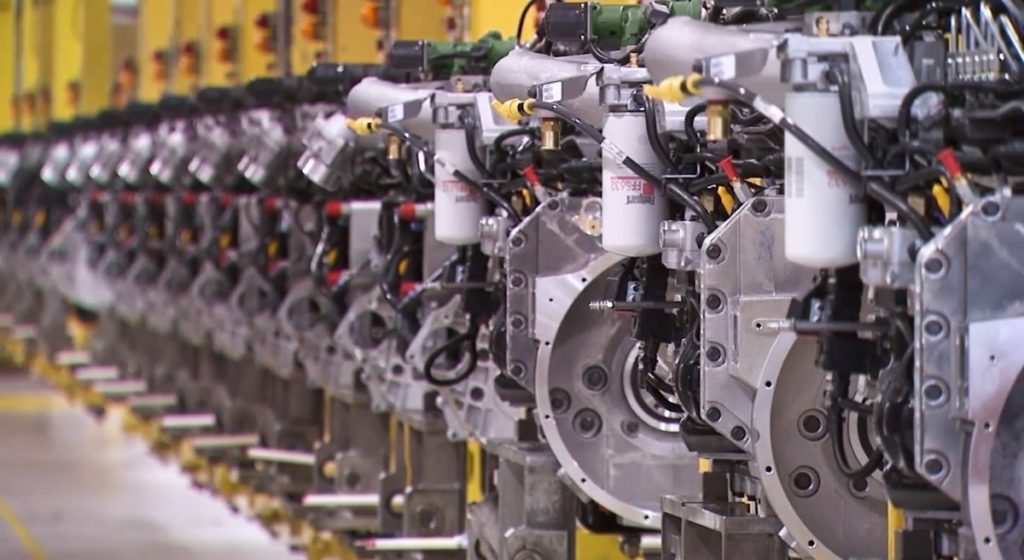Digitizing industrial products at Cummins
Aug 5, 2020

Everything about Cummins is big. The Fortune 500 company manufactures engines for big vehicles, employs 63,000 people, generates $23 billion in sales, and operates all over the globe. With digital technologies making their way into Cummins’ products, much about this big company is changing all at once, including IT’s role in product engineering, the sales team’s approach to new digital products, and leadership’s mindset around data. CIO Sherry Aaholm says that her approach to driving change over so much scale centers on demonstrating business value, and a lot of patience.
Martha Heller: What does digital strategy mean to Cummins?
Sherry Aaholm: Our digital strategy has two elements to it: The first is core infrastructure, where we are digitizing hard documents and physical processes and moving them to the cloud.

Sherry Aaholm, CIO, Cummins
Field service operations is one example. Many of our products, like the engines we put in locomotives or in dump trucks used in mines, require field service technicians because the products are too big to service in a shop.
Traditionally, the technicians would check the safety of the site on a piece of paper before going into the field. Today, that process is digital. Service technicians are able to capture, through pictures and commentary, what they’re actually seeing at the site. We then use imaging analysis to give our team leaders, who are in regional offices around the world, real-time reports and assess whether there are safety issue patterns across multiple sites.
We can then push safety equipment recommendations to technicians based on what we’ve learned from other people in the field. That’s an example of doing more than automating a “pencil lifting” process. We are actually creating a safer field experience.
But digitizing processes is table stakes; all of our competitors are doing it. As a tier one provider to OEMs, our competitive advantage lies in digitizing our products and inventing ways to help the end customer out in the field. That’s the second element of our digital strategy.
We sell engines and power generation units, so uptime is very important to our end customers. Through IoT, we are pulling insights off of the engines in the field that tell our end customer how to operate their vehicles more efficiently and how to go longer between servicing. Our end customers are getting better fuel economy and reduced emissions.
In the mining industry, it can cost a mine $10,000 every day that a digger is out of commission, but mines don’t all operate the same way, and they can be at different altitudes, which impacts an engine’s performance. Our ability to run artificial intelligence on the data coming off the engines allows us to give mine owners better uptime and utilization.
How are you changing your IT organization to drive product digitization?
Like most manufacturing companies, Cummins IT has always run core enterprise technology for payroll, finance, and the shop floor. We are now creeping into the product engineering space, which is important because we have a better understanding of cyber security and software development than our product engineers.
The challenge has been to change the skillset of the IT organization from buying and installing software packages to building software as intellectual property. I started by building a completely new software engineering team, staffed with people who have IoT experience.
We are now taking what we are learning from this new software engineering group and bringing new software development tools and practices into the “traditional” IT organization, so that we can think differently about the core enterprise.
DevOps, for example, was born in the digital product group, so we are migrating that capability to enterprise IT as we put more core systems into the cloud. Our digital products group uses Agile development, so we are starting to train enterprise IT on Agile, too.
How are well are your business partners embracing your digital strategy?
We had some friction with the engineering team because they never thought of IT as part of the product. We had to explain to them that we are an important part of product design, because every new product release should include some base digital features. Getting engineering comfortable with the role that IT plays in product development is a work in progress.
It has also been a challenge to get our sales teams to understand the market value of our digital products. They want to give the insights away as a value-add to our traditional products, as opposed to charging for it. To help drive change here, I included people with marketing and pricing backgrounds in our digital product group; they are creating new collateral about our digital products and educating our business partners.
Getting our business partners on board is still a work in progress, but it is being supported by market demand. Three or four years ago, when we were building our digital product strategy, the business units would say, “This is kind of a nice thing, but none of our customers are actually asking for this.” But today, all of the OEMs are digitizing their products, so our business units know that if we don’t, we will lose our competitive advantage.
The product development cycle for building an engine is seven years, so we have to put IoT devices in the product before we understand exactly what the market for those products will be. This means we have to put in some capabilities without knowing exactly how we are going to use them. Getting people in that “build it without a clear business case” mindset is one of our most difficult challenges.
What has been your approach for creating a data-driven business?
The first has been to get executive support for democratizing the data. Data tends to be very fragmented across an enterprise with business units believing that they own the data. One business unit might refuse to share their data with another business unit out of fear of what they might do with it. You cannot do much with data until your CEO makes it clear that data belongs to everybody, not to a powerful few.
The second has been to start cleaning only the data that is going to solve a clear business problem. If I went around this company and said, “I need all of the manufacturing data to be clean and in one place,” people would say, “That sounds really expensive. Why would you do that?” and it would take me 100 years.
Instead, we have been taking some of our bigger questions, like how to use analytics to drive down warranty costs, and cleaning up only that data. Taking a “use the data to solve a specific problem” approach, we identified around 50 key sources of relevant data and then whittled that down 20. We cleaned that data and put it into a data lake and made it available for people, but only for real business problems. Can we identify customer warranty problems without issuing a full customer campaign? Can we use usage patterns to identify which engines will have an issue? Can we improve uptime?
When we started demonstrating that we could solve big problems, people started believing in the data and asking for more.
The third prong to our approach has been with data privacy. Much of our data comes from the end customer vehicle, which is released to us for our analysis, but is not actually ours. Our legal department has been very helpful in guiding us to pull the data out of all these little crevices and pull it together into one place, because that’s the only way we can ensure we are protecting the privacy on it.
Our approach to data involves all three of these legs. Are we done? Absolutely not. We’re probably an eighth of the way through. But our business leaders now know that data is an asset just like a manufacturing plant is an asset. We have a long way to go, but we are moving in the right direction.
Martha Heller is CEO of Heller Search Associates, an IT executive recruiting firm specializing in CIO, CTO, CISO and senior technology roles in all industries. She is the author The CIO Paradox: Battling the Contradictions of IT Leadership and Be the Business: CIOs in the New Era of IT. To join the IT career conversation, subscribe to The Heller Report.
Original Article: https://www.cio.com/article/3568493/digitizing-industrial-products-at-cummins.html#tk.rss_digitaltransformation
Stay In Touch.
Subscribe to our newsletter and exclusive Leadership content.
